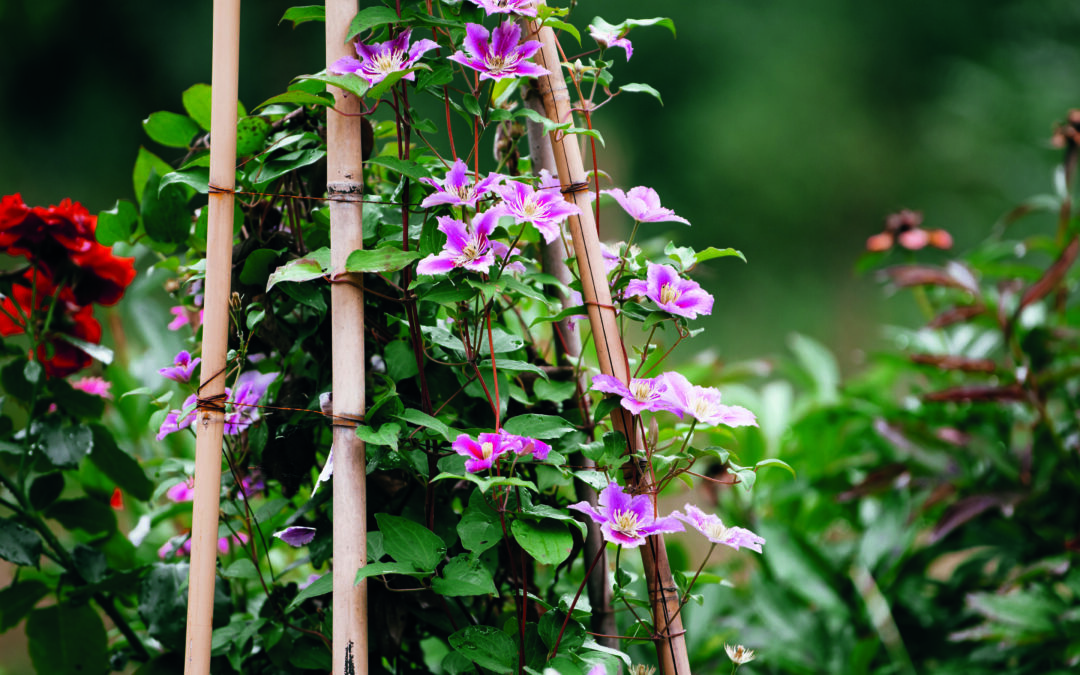Climbers help green up and soften fences, maximising vertical spaces – so important in London gardens. They work well intertwined with evergreen climbers and roses, adding seasonal colour. Right now, you’ll see pale pink montanas sprawling along walls and up trees, but there’s a clematis for every season, in a mouth-watering array of colours. Here’s my pick:
Spring: First up in March are C. armandii – such as C a. ‘Enham Star’ or pink- tinged ‘Apple Blossom’. C. Early Sensation’ is a neater evergreen clematis with masses of white flowers. The delicate bell-shaped flowers of alpine varieties (Mid March to Mid May) include deep blue ‘Frances Rivis’ and mid-pink ‘Constance.’ The frillier, multi petalled C. macropetalas such as gorgeous grey-blue ‘Lagoon ‘is a must.
Cultivation: Armandii is happy in shade. Alpines tend to cope with semi shade and work on a north facing wall. These (Group 1) clematis need a prune and tidy up after flowering to remove dead shoots and to keep them to their allotted space.
Early summer: If you like big exotic flowers, early summer varieties are for you. The blousy ‘Nelly Moser’ is the most famous, or try the purple ‘The President’ (June – Sept). I adore ‘Niobe’ (May – October) which has deep ruby red flowers with golden yellow centres – stunning!
Cultivation: They tend to prefer a sunny spot with well-drained soil. Remove dead and damaged stems of Group 2 clematis in late February, cutting remaining stems by around a third, back to strong buds in early spring.
Late summer: Later flowering varieties tend to have smaller flowers, start flowering in July and go on until September and sometimes later. Clematis ‘Etoile Violette’ has rich velvety purple flowers and yellow gold stamens, C. ‘Madame Julie Correvon’ is a plum red, while ‘Purpurea Plena Elegans’ is a delicate pale plum double.
Clematis ‘Perle d’Azur’ has gorgeous large sky-blue flowers and C. ‘Prince Charles’ is similar but more compact. C. ‘Jackmanii’ is vigorous and reliable with large velvety dark purple flowers with light greenish brown anthers. It copes with a bit of shade and looks great scrambling between climbing roses such as the pink ‘New Dawn’ or yellow ‘Golden Showers’.
Cultivation: They’ll cope with semi shade but most prefer sun. Pruning for group 3 clematis is easy – cut back old growth to 23/45 cm from the ground in early spring to just above strong bud.
Autumn: C. ‘Gravetye Beauty’ is an elegant late flowering clematis with cherry red blooms. C. ‘Bill MacKenzie’ is a popular late flowering clematis with masses of lemon-coloured flowers and then puffball seeds into late autumn.
Cultivation: Clematis ‘Gravetye Beauty’ tends to die off to the ground in winter before starting afresh and likes a sunny spot. C. ‘Bill MacKenzie’ thrives on a north wall and drapes a fence elegantly for longer than most plants. Sheer it back in Feb.
Winter clematis: Evergreen clematis cirrhosa varieties, starting to bloom in December in a sheltered spot and can flower into spring with nodding bell-shaped flowers. Clematis var. purpurascens ‘Freckles’ has lovely plum spots over cream flowers and ‘Wisley Cream’ is a plain creamy green.Cultivation: Likes full sun or part shade in a sheltered spot. Keep it to size by neatening it up after flowering.

